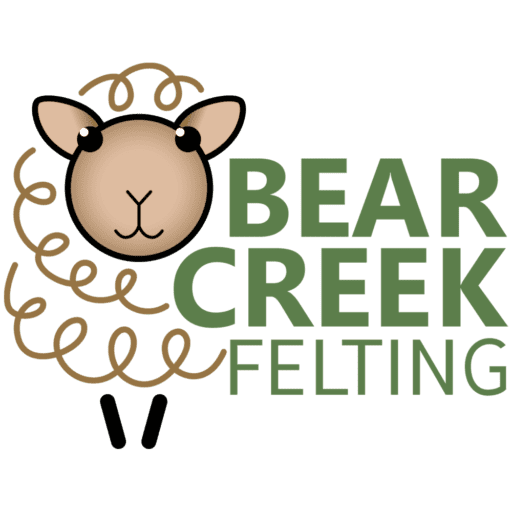 If you were raised on a farm like I was, then you probably already know where wool comes from. For those who might not be so sure, it comes from sheep. The coat of other animals is also sometimes blended with wool, such as alpaca, rabbit, and so on. The wool that we use in most of our needle felting projects is from the sheep we raise at our own farm, Bear Creek Ranch, or blended with alpaca wool that is also locally sourced. In fact, we raise a flock of Romney, Blue Faced Leicester, and Cormo sheep, along with a few other animals. Our sheep are primarily raised for their wool, which we harvest around this time of year just as the time is getting warmer.
If you were raised on a farm like I was, then you probably already know where wool comes from. For those who might not be so sure, it comes from sheep. The coat of other animals is also sometimes blended with wool, such as alpaca, rabbit, and so on. The wool that we use in most of our needle felting projects is from the sheep we raise at our own farm, Bear Creek Ranch, or blended with alpaca wool that is also locally sourced. In fact, we raise a flock of Romney, Blue Faced Leicester, and Cormo sheep, along with a few other animals. Our sheep are primarily raised for their wool, which we harvest around this time of year just as the time is getting warmer.
Many people believe that wool shearing is dangerous and harmful to the sheep. “Doesn’t wool shearing hurt the sheep?” they ask. Does it hurt when you get a haircut? Although it’s a bit more intricate, wool shearing is like giving your sheep a haircut. If you live in warm climates, you probably give your dogs regular trims around the hotter periods of the year. Shearing wool has the same kind of impact on sheep.
Sheep wool helps to regulate their body temperatures. A thick layer of wool is essential for keeping them warm during cold winter months, but a much thinner layer is still needed during very hot summer months. When the wool is sheared during spring, it can regrow just in time for summer, but not too much. They need a layer of wool during the hotter summer period to prevent sunburn and overheating. Sheep are most comfortable in temperatures between 45 and 70 degrees Fahrenheit. In fact, adult sheep can survive outdoors in the winter. The babies can’t survive the extremely cold months in North Dakota without shelter naturally because they don’t have enough wool. Many shepherds lamb in January, but they have barns and ways to keep them warm enough. We lamb in April since our facility is not large enough. Shearing them now allows for enough growth not just for the summer heat in our North Dakota climate but also for the coming winter months.
Now, apart from trimming the sheep to keep them cool around this time of year, it’s also beneficial to do so just before lambing. We have quite a number of ewes, who have recently given birth, and shearing them can make birthing healthier and easier. Since the sheep’s fleece can retain lots of moisture, whether they’re raised indoors or outdoors, this can create a breeding ground for insects and pathogens and pose a threat to the unborn lamb. Dirt, feces, urine, and fluid from the birthing process can also get caught in the wool. So, shearing them encourages a drier and healthier environment for both ewe and her offspring(s).
Ewes are easier to shear at this point rather than after giving birth. Their fleece tends to start getting sticky when they get to the peak of their lactation cycle, usually about a month afterward. Shearing the wool at this point also gives you better quality fibers. The stress brought on during late pregnancy and early lactation can weaken the wool and cause it to break. The best thing about shearing the wool pre-lambing is the fact that the offspring can easily access their mother’s teat. This definitely helps to increase their chances of survival.
Shearing can be done with a manual razor and blade, or with a special electronically-operated clipper. On our ranch, we use cruelty-free methods and techniques. Our shearing provider uses a safe industrial-type electronic clipper. They also handle our flock with care and gentleness during the entire process. The shearing process per ewe can vary depending on the size. A professional sheep shearer can typically take around three (3) minutes per sheep. After shearing, the wool is picked and skirted then washed with an organic solvent. This is necessary for removing dirt, dust, and grease. They are then put to dry and then spun into yarn or carded for roving.
If you use wool or yarn for your art and crafts projects, check out our all-natural and eco-friendly USA-grown wool supplies. We have a range of wool sampler kits and Dakota Spun yarns. They are available in varying shades of natural colors, like white, brown, black, and gray, as well as dyed colors. You can choose from a wool sampler kit with single colors or a blend of different colors.





